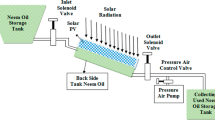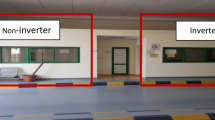Abstract
When a vehicle is parked under the summer sun, to avoid the passenger discomfort caused by high cabin temperature, the performance of forced ventilation, which is called pre-ventilation, using a solar sunroof integrated with a photovoltaic (PV) cell to reduce cabin thermal load is investigated numerically in this study. The vehicle pre-ventilation system is composed of a solar sunroof, DC/DC converter, and air handling system. The indoor thermal load is reduced by the hot cabin air that moves when outside air is supplied to the cabin. The simulation model is established with the component and system model approach using Dymola, and the numerical analysis results are compared with the experimental data. Using the validated model, pre-ventilation performance is analyzed with 40-, 80-, and 120-W PV cells in each solar sunroof system. The results indicate that the 40-W PV cell in the solar sunroof is sufficient for this pre-ventilation application considering cost and cabin thermal comfort performance. Further, the effects on cabin space and DC/DC converter efficiencies were investigated. The analysis results show that cabin volume slightly affected cabin temperature, whereas the efficiency of DC/ DC converter was not significantly affected by cabin temperature reduction.
Similar content being viewed by others
Abbreviations
- A :
-
area (mm2)
- c p :
-
specific heat constant pressure (kJ/kg∙K)
- h :
-
enthalpy (kJ/kg)
- ṁ :
-
mass flow rate (kg/h)
- Q :
-
heat capacity (W)
- T :
-
temperature (°C)
- a :
-
air
- cond :
-
conduction
- conv :
-
convection
- m :
-
mass
- rad :
-
radiation
- v :
-
ventilation
References
Autoevolution (2017). https://doi.org/www.autoevolution.com/news/audi-makes-first-solar-sunroof-that-s-also-practical-and-improves-ev-range-120032.html
Bharathan, D., Chaney, L., Farrington, R. B., Lustbader, J., Keyser, M. and Rugh, J. (2007). An overview of vehicle test and analysis from NREL’s a/c fuel use reduction research. Proc. Vehicle Thermal Management Systems Conf. and Exhibition, Nottingham, UK.
Chiou, J. P. (1986). Application of solar-powered ventilator in automobiles. SAE Paper No. 860585.
Jang, K., Kim, H., Lee, D. and Oh, D. (2010). Study on the pre-ventilation of automotive climate control system using solar energy. Spring Conf. Proc., Korean Society of Automotive Engineers, 23–28.
Joerg, D., Low, W. B., Ayush, K. P. and Luo, Y. (2015). Multifunctional solar charging station for electric vehicles. Proc. EVS28, KINTEX, Korea.
Kim, S. Y., Kim, S. M. and Kim, H. K. (2005). Trends and test method for TVOC regulation of the vehicle interior’s environment. Fall Conf. Proc., Korean Society of Automotive Engineers, 2054–2059.
Kline, S. J. and McClintock, F. A. (1953). Describing uncertainties in single-sample experiments. Mechanical Engineering, 75, 3–8.
Lee, D. (2014a). Study of pre-ventilation effects on the cabin thermal load. Trans. Korean Society of Automotive Engineers 22, 5, 84–90.
Lee, D. (2014b). An experimental study on the benefit of pre-ventilation using solar sunroof. Trans. Korean Society of Automotive Engineers 22, 6, 89–95.
Ozeki, Y., Hirita, Y., Hirano, A. and Nishihama, J. (2014). Evaluation on the solar reduction glass in an electric vehicle by experimental measurements in a climate chamber. SAE Paper No. 2014-01-0703.
Paul, Y. and Van Esso, R. A. (1989). A solar control glass for automobiles. SAE Paper No. 890311.
Rugh, J. P., Chaney, L., Lustbader, J., Mayer, J., Rustagi, M., Olson, K. and Kogler, R. (2007). Reduction in vehicle temperatures and fuel use from cabin ventilation, solar-reflective paint, and a new solar-reflective glazing. SAE Paper No. 2007-01-1194.
Rugh, J. P., Hendricks, T. J. and Koram, K. (2001). Effect of solar reflective glazing on Ford Explorer climate control, fuel economy, and emissions. SAE Paper No. 2001-01-3077.
Rugh, J., Chaney, L., Ramroth, L. and Venson, T. (2013). Impact of solar control PVB glass on vehicle interior temperature air-conditioning capacity, fuel consumption, and vehicle range. SAE Paper No. 2013-01-0553.
Webasto, A. G. (2007). Solar Tilt/Slide Sunroof Special Equipment for Ventilating and Cooling Interior When Stationary. https://doi.org/www.webasto.com
Author information
Authors and Affiliations
Corresponding author
Rights and permissions
About this article
Cite this article
Lee, D., Lee, H. Numerical Study of Pre-Ventilation Effects on Cabin Temperature Using Solar Sunroof. Int.J Automot. Technol. 20, 1173–1181 (2019). https://doi.org/10.1007/s12239-019-0110-z
Received:
Revised:
Accepted:
Published:
Issue Date:
DOI: https://doi.org/10.1007/s12239-019-0110-z




